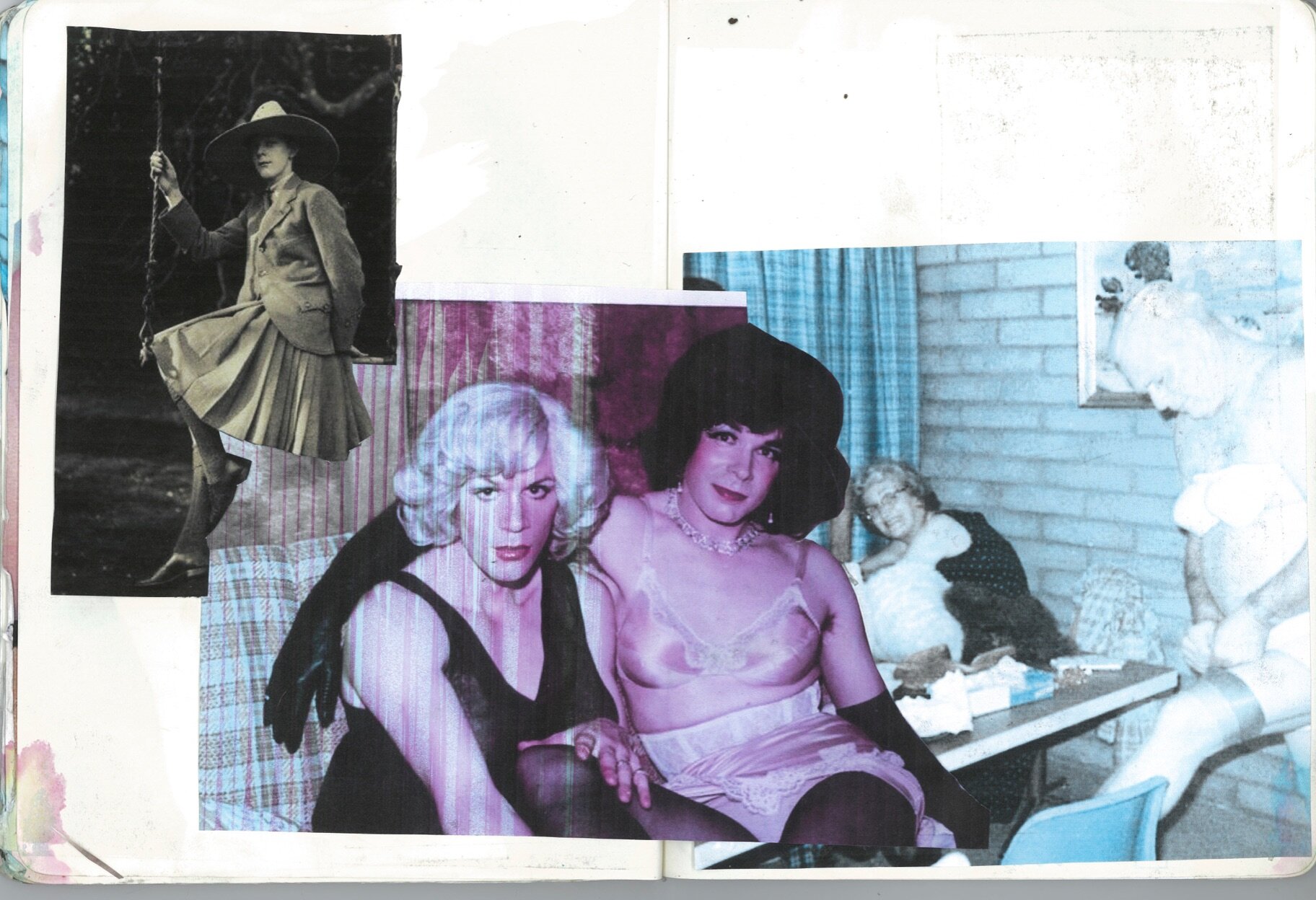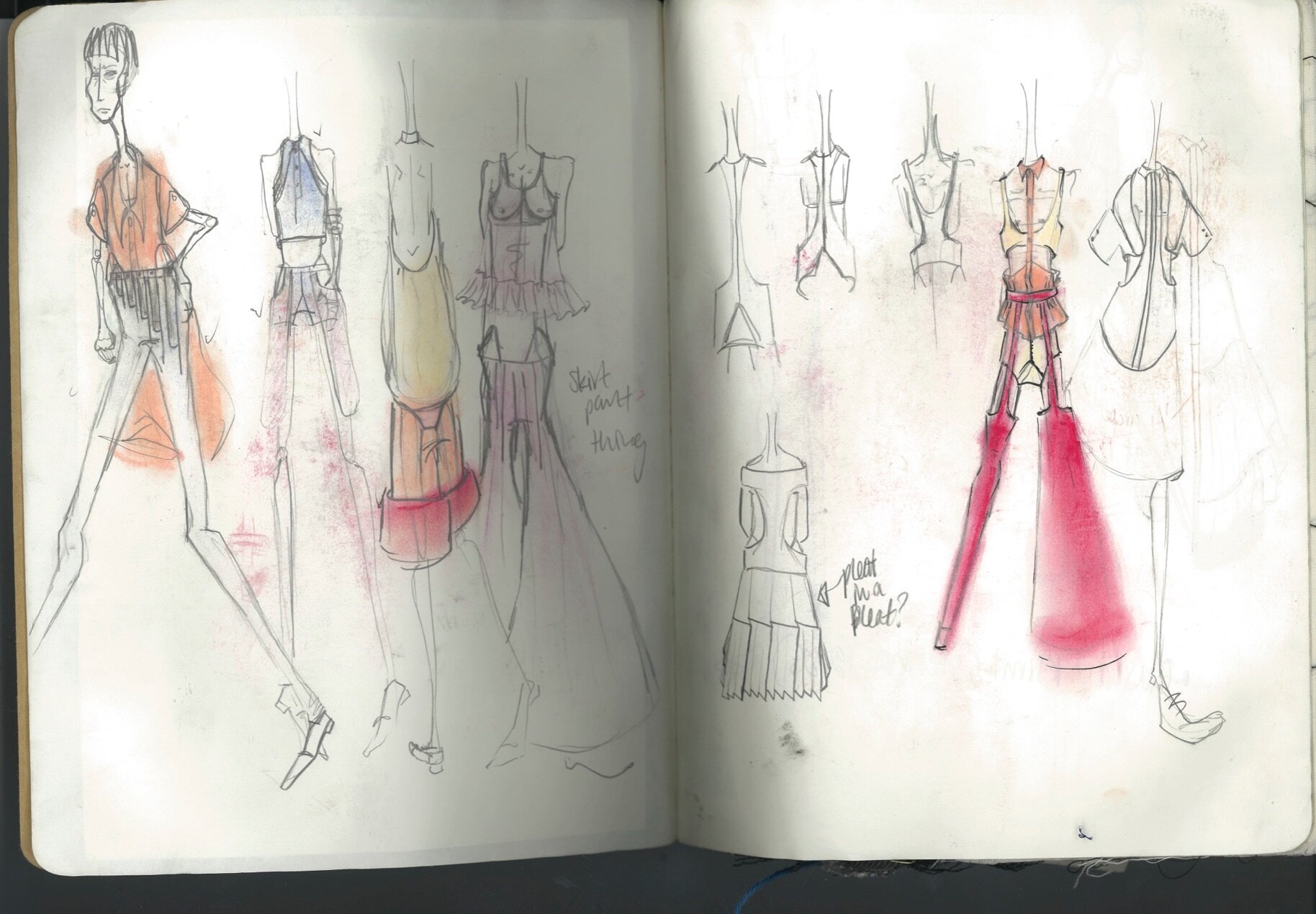



Queer For A Living
Gender-fluid fashion professional Aaron Myers explores what it means to be queer today.
Published on Fluid Magazine and Fashion School Daily
An electronic soul beat flows through the headphones of 24 year old Aaron Myers as he waits for the J train. The music allowing the daily commute to the office to be transformed into an immersive independent documentary of Aaron’s own creation. The train will take him over the Williamsburg Bridge with the cityscape of New York City serving as the backdrop and a reminder of life in the city. Delays come and go, allowing the momentum created by morning rush hour to lose steam. Upon arrival Canal Street, Aaron transfers to an express train which takes him to 42nd St./Times Square. He walks through the landmarked station to his office as a trend and concept designer at the renowned fashion brand Vince Camuto.
Adorned in t-shirt with the face of a tiger as its central point, bloomers, knee-high socks, and rounded framed glasses, Aaron is an intriguing visibly queer, gender-fluid, fashion advocate. He stands as a strong representation of contemporary young adults in a major metropolitan city: AMAB* frame expressed in feminine silhouettes. In fact, as of 2018, 11 million U.S. Adults identify within the LGBTQIA+ community Gallup estimates. Although making up 4.5% of the population, and labeled as minorities, their number is rising across the world.
*Acronym for Assigned Male At Birth, term for gender based body type.
Despite that, the visibility Aaron brings on the subway leads to odd looks from fellow commuters.
“Most of the time, I don’t give a shit. I don’t need people’s energy” Aaron said nonchalantly. Apparently, he is used to stares from strangers. It is his livelihood. Taking inspiration, communicating them in fashion, and pushing the envelope is in his job description. Vince Camuto allowing him to establish himself around professionals, who look to Aaron for creative. His fully realized, undeniable queer fashion professionalism, of course brings with it many misunderstandings and isolation.“I’m Aaron first and foremost and that is how I view everything around me. That is how I dress, I dress from myself,” he shrugs with an unquestionable confidence.
The social consciousness continues to expand due to more visible queer culture as well as the gender revolution across multiple outlets. Fashion, in particular, has been an industry that has not only accepted but advocated for a large proportion of LGBTQIA+ pioneers to excel in this creative field. “Many of the greatest names in twentieth-century fashion were gay or bisexual, including such figures as Christian Dior, Cristobal Balenciaga, Yves Saint Laurent, Norman Hartnell, Halston, etc,” said Shaun Cole, writer specializing in menswear and gay fashion at the University of London. The idea of fashion as a creative industry is still stigmatized with the notion that men in fashion and predominately gay. When in the corporate world of fashion, Aaron expresses, is far from reality.
Walking into the office, Aaron again is the minority of his surroundings. Amidst corporate cisgendered men in traditional suits, Aaron is adorned in a light blue frock, accessorized with pink knee-high socks on his feet, and a brilliantly red floral patterned scarf around his neck.
“A higher up once came up to my boss and congratulated them by saying, ’We are so proud of you for hiring a trans-person!’”Aaron recalls with amusement. “It’s funny because that isn’t my situation at all, but for the most part, gendered politics is new and I understand why many are confused,”shared Aaron.“When people don’t understand the new realms of queerness, they see it through HR inclusive kind-of-moment,” he said. A sentiment that is true, especially when a disproportionate amount of men, heteronormative men in particular, make up the c-suite of most fashion conglomerates today.
“Every time I go to a meeting, people have to engage with my queerness in an authoritative way that demands respect” Aaron shares. “It is something people need to see. There are people like me out in the world and if I’m your point of contact, I want to be happy and I want to show that I’m a professional person; and so what if I’m wearing a skirt or a weird dress,” he expresses passionately. Aaron, as a person, is someone who with his words and appearance, expresses a desire to see queer professionals be more respected, without potential consequences of being forced to change, or worse, driven into seclusion.
“I’m sure, if they saw me on the street without any context it would be a different story,” Aaron admits. “I wouldn’t be interacting with ‘higher-ups’ if I didn’t have some sort of respectability, and, in that way, I like to think I have some visibility when it comes to these people.” For Aaron visibility means a number of things: whether it be in the exploitive use of queer identity in media, or consumerism, or the fact that the idea of gender-neutral clothing cannot be established until we address the idea of body types in new ways within fashion.
Contradictory to the harsh fluorescent lighting, beige cubicles, and dying desk plants that are now the space to see gender-fluid inspired fashion, nightclubs and bars were once the fluid fashion meccas where the queer community truly flourished. Most of which are used for inspiration in fashion, with little to no recognition of their queer roots. With the millennial- and Z-generations coming of age, Aaron included, LGBTQIA+ fashion, art and culture are starting to surface within a traditional workspace environment, in a way that wasn’t available to previous generations. Those who would have typically utilized underground spaces for working opportunities, aka club kids, nightlife performers, and other gender-bending individuals, have more of an opportunity to step out into the daylight and hoping leading American companies.
“I’m here to normalize queerness” Aaron says. “Seeing queerness everyday will only help to make life easier, and that’s the hope for each generation. That the “work” and visibility that is happening now will make the generation after us and then them and etc. will make life easier.”
Born and raised in Tennessee, Aaron addresses the ideas of queerness in parts of the world that don’t have the same history as New York. “I would argue that this rural visibility alone is more important than any queer person in a metropolitan area,” he states. “I think that this rural visibility is why I think the way I do as far as trying to make queerness everyday,” Aaron expresses. Making a point to communicate the huge disconnect between visibility being celebrated in New York, and being completely condemned in his home of Appalachia. “If my voice isn’t for them, then it’s for nobody,” he affirms, making the point to stress the importance of legislation and education.
The ‘work’ being a process that begins when Aaron steps on the commuter train, and is continued throughout the day as he engages with fashion executives, and how his own work as a designer and advocate is able to be seen by others. “What is a professional attire?” he philosophically asks, leading the question to sink into my mind, vaguely unanswered.
Aaron being incredibly self-reflective, acknowledges his own privileges as a white, male bodied person. He is cautious to warn me about stating that his thoughts and opinions are not of the collective queer voice. An effect of conscious that can be closely associated with the newness and uncertainty when it comes to how gender identity is seen and understood. In the workplace, the understanding is even more convoluted. He dreams of the perfect moment when”…seeing queer people and specifically young queers being fearless and self assured, without harassment.” This is the sentiment that Aaron uses to navigate his place in fashion.
As a society that is changing, with concerned acceptance and visibility of queer identity is becoming a part of the cultural zeitgeist in a number of manifestations. The opportunities for understanding and change remain immense. “It’s going to be hard and you have to be diligent,” Aaron admits, “because we are in the fashion industry, Never settle your identity or what you wear for anybody as long as you maintain a professional attitude.”
With similarly held beliefs about queer identity and my search to find a place within fashion, there was a need to hear someone say that in the workforce, visibly queer people have a safe and non-marginalized space. And although that wasn’t necessarily the answer to many of my conversations with Aaron, the twinkle of hope that, in Aaron’s case, queer identity doesn’t stifle a persons ability to succeed as a professional is a perspective that, in fashion, can be overlooked. This due to the stigma of fashion being, well, extremely flamboyant.
Aaron teaches us that queer identity doesn’t have to be sacrificed from professionalism. Professionalism, no matter the ensemble or accessories comes from a place of self-acceptance, love and understanding. A lesson that we learned from a young man in a dress who is establishing what it means to be queer for a living.
